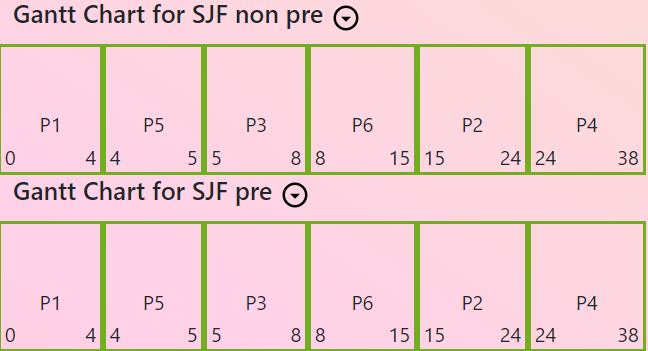Scheduling exercises
Test yourself with this website
Let's practice the algorithms:
Given those processes:
| Process | Arrival time | Burst time (ms) |
|---|---|---|
| P1 | 1 | 4 |
| P2 | 0 | 3 |
| P3 | 3 | 5 |
| P4 | 2 | 8 |
| P5 | 3 | 1 |
| P6 | 2 | 7 |
| P7 | 4 | 5 |
Exercise 1: Apply Round Robin with q = 3 and write the Gantt chart
💡Answer

A solution is to add them by arrival time. P1, then P4, P6, and P3, P5.
Queue time 0 :
| Process | Time left |
|---|---|
| P2 | 3 |
Queue time 3:
| Process | Time left |
|---|---|
| P1 | 4 |
| P4 | 8 |
| P6 | 7 |
| P3 | 5 |
| P5 | 1 |
Queue time 6:
| Process | Time left |
|---|---|
| P4 | 8 |
| P6 | 7 |
| P3 | 5 |
| P5 | 1 |
| P7 | 5 |
| P1 | 1 |
(we've added P7 first, and then P1)
...
Exercise 2: Calculate average wait time for the Round Robin with q = 3
💡Answer
P1 : 2 + 13 = 51 wait time
P2: 0
P3: 12 - 3 + 26 - 15 = 18
P4: 4 + 11 + 7 = 32
P5: 12
P6: 7 + 11 + 6 = 24
P7: 12 + 9 = 21
Avg wait time: 16
Exercise 3: write the gantt chart for SJF preemptive
💡Answer

On the exam, you can split in multiple boxes from 1 to 1 time unit.
e.g. P2 0 1, P2 1 2, P2 1 3... (to illustrate that you verify for other processes) (but specify you don't do a context switch there)
Exercise 4: Average time for SJF preemptive.
Given this table with processes:
| Process | Arrival time | Burst time (ms) | Priority |
|---|---|---|---|
| P1 | 0 | 4 | 3 |
| P2 | 2 | 3 | 5 |
| P3 | 4 | 5 | 1 |
| P4 | 2 | 8 | 2 |
| P5 | 3 | 1 | 4 |
| P6 | 6 | 7 | 5 |
Exercise 5: Do the Gantt chart for SJF preemptive and non-preemptive
Hint: When you are running a process, if another comes with a bigger priority or same one but smaller burst time, context switch. After you end the process, take the smallest job first.
💡Answer
